Book contents
- Frontmatter
- Contents
- Preface
- Introduction
- PART I DISCOURSE STRUCTURE
- 1 The study of discourse
- 2 Introduction to the Discourse Modes
- 3 Text representation and understanding
- PART II LINGUISTIC ANALYSIS OF THE DISCOURSE MODES
- PART III SURFACE PRESENTATIONAL FACTORS
- PART IV DISCOURSE MODES AND THEIR CONTEXT
- Appendix A The Texts
- Appendix B Glossary
- References
- General index
- Index of names
3 - Text representation and understanding
Published online by Cambridge University Press: 18 June 2010
- Frontmatter
- Contents
- Preface
- Introduction
- PART I DISCOURSE STRUCTURE
- 1 The study of discourse
- 2 Introduction to the Discourse Modes
- 3 Text representation and understanding
- PART II LINGUISTIC ANALYSIS OF THE DISCOURSE MODES
- PART III SURFACE PRESENTATIONAL FACTORS
- PART IV DISCOURSE MODES AND THEIR CONTEXT
- Appendix A The Texts
- Appendix B Glossary
- References
- General index
- Index of names
Summary
Text understanding is a constructive process that results in a mental representation. In this it is rather like vision. Seeing a tiger, for instance, is the result of a process of construction. The perceiver's mind/brain converts information from a pattern of light and dark on the retina to a representation, an interpretation of the object – an image of a tiger (Marr 1982). Inference often plays an important role at the final stages. Similarly, to understand a sentence, one goes from a sound wave or set of marks to a conceptual representation which brings together information of different kinds, some of it supplied by inference and world knowledge. The active nature of understanding informs the approach to text structure and its representation that I take here.
Studies in cognitive science and psycholinguistics provide background information about text understanding and mental models. Mental models are developed in effect with the structures of Discourse Representation Theory.
Section 3.1 discusses the communicative context of language; 3.2 considers some inferences in language understanding; 3.3 relates language understanding to the notion of mental models; 3.4 discusses the analysis of text passages in Discourse Representation Theory, and introduces the rules and structures of the theory.
The pragmatic background for discourse interpretation
Participants in discourse have in common several kinds of knowledge. They may share a general background and specific knowledge about the particular language activity of a given discourse.
- Type
- Chapter
- Information
- Modes of DiscourseThe Local Structure of Texts, pp. 49 - 64Publisher: Cambridge University PressPrint publication year: 2003



